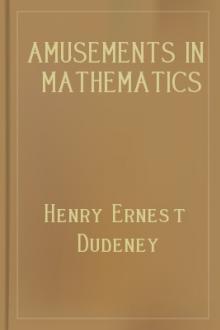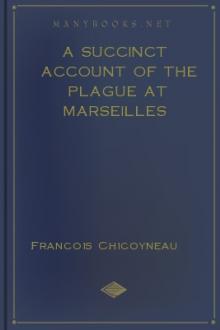Amusements in Mathematics, Henry Ernest Dudeney [books to read to be successful txt] 📗

- Author: Henry Ernest Dudeney
- Performer: 0486204731
Book online «Amusements in Mathematics, Henry Ernest Dudeney [books to read to be successful txt] 📗». Author Henry Ernest Dudeney
A common cause of error is this. If you calculate your combinations by working upwards from a basic triangle lying on the table, you will get half the correct number of ways, because you overlook the fact that an equal number of pyramids may be built on that triangle downwards, so to speak, through the table. They are, in fact, reflections of the others, and examples from the two sets of pyramids cannot be set up to resemble one another—except under fourth dimensional conditions!
281.—PAINTING A PYRAMID.—solution
It will be convenient to imagine that we are painting our pyramids on the flat cardboard, as in the diagrams, before folding up. Now, if we take any four colours (say red, blue, green, and yellow), they may be applied in only 2 distinctive ways, as shown in Figs, 1 and 2. Any other way will only result in one of these when the pyramids are folded up. If we take any three colours, they may be applied in the 3 ways shown in Figs. 3, 4, and 5. If we take any two colours, they may be applied in the 3 ways shown in Figs. 6, 7, and 8. If we take any single colour, it may obviously be applied in only 1 way. But four colours may be selected in 35 ways out of seven; three in 35 ways; two in 21 ways; and one colour in 7 ways. Therefore 35 applied in 2 ways = 70; 35 in 3 ways = 105; 21 in 3 ways = 63; and 7 in 1 way = 7. Consequently the pyramid may be painted in 245 different ways (70 + 105 + 63 + 7), using the seven colours of the solar spectrum in accordance with the conditions of the puzzle.

282.—THE ANTIQUARY'S CHAIN.—solution

The number of ways in which nine things may be arranged in a row without any restrictions is 1 × 2 × 3 × 4 × 5 × 6 × 7 × 8 × 9 = 362,880. But we are told that the two circular rings must never be together; therefore we must deduct the number of times that this would occur. The number is 1 × 2 × 3 × 4 × 5 × 6 × 7 × 8 = 40,320 × 2 = 80,640, because if we consider the two circular links to be inseparably joined together they become as one link, and eight links are capable of 40,320 arrangements; but as these two links may always be put on in the orders AB or BA, we have to double this number, it being a question of arrangement and not of design. The deduction required reduces our total to 282,240. Then one of our links is of a peculiar form, like an 8. We have therefore the option of joining on either one end or the other on every occasion, so we must double the last result. This brings up our total to 564,480.
We now come to the point to which I directed the reader's attention—that every link may be put on in one of two ways. If we join the first finger and thumb of our left hand horizontally, and then link the first finger and thumb of the right hand, we see that the right thumb may be either above or below. But in the case of our chain we must remember that although that 8-shaped link has two independent ends it is like every other link in having only two sides—that is, you cannot turn over one end without turning the other at the same time.
We will, for convenience, assume that each link has a black side and a side painted white. Now, if it were stipulated that (with the chain lying on the table, and every successive link falling over its predecessor in the same way, as in the diagram) only the white sides should be uppermost as in A, then the answer would be 564,480, as above—ignoring for the present all reversals of the completed chain. If, however, the first link were allowed to be placed either side up, then we could have either A or B, and the answer would be 2 × 564,480 = 1,128,960; if two links might be placed either way up, the answer would be 4 × 564,480; if three links, then 8 × 564,480, and so on. Since, therefore, every link may be placed either side up, the number will be 564,480 multiplied by 29, or by 512. This raises our total to 289,013,760.
But there is still one more point to be considered. We have not yet allowed for the fact that with any given arrangement three of the other arrangements may be obtained by simply turning the chain over through its entire length and by reversing the ends. Thus C is really the same as A, and if we turn this page upside down, then A and C give two other arrangements that are still really identical. Thus to get the correct answer to the puzzle we must divide our last total by 4, when we find that there are just 72,253,440 different ways in which the smith might have put those links together. In other words, if the nine links had originally formed a piece of chain, and it was known that the two circular links were separated, then it would be 72,253,439 chances to 1 that the smith would not have put the links together again precisely as they were arranged before!
283.—THE FIFTEEN DOMINOES.—solution
The reader may have noticed that at each end of the line I give is a four, so that, if we like, we can form a ring instead of a line. It can easily be proved that this must always be so. Every line arrangement will make a circular arrangement if we like to join the ends. Now, curious as it may at first appear, the following diagram exactly represents the conditions when we leave the doubles out of the question and devote our attention to forming circular arrangements. Each number, or half domino, is in line with every other number, so that if we start at any one of the five numbers and go over all the lines of the pentagon once and once only we shall come back to the starting place, and the order of our route will give us one of the circular arrangements for the ten dominoes. Take your pencil and follow out the following route, starting at the 4: 41304210234. You have been over all the lines once only, and by repeating all these figures in this way, 41—13—30—04—42—21—10—02—23—34, you get an arrangement of the dominoes (without the doubles) which will be perfectly clear. Take other routes and you will get other arrangements. If, therefore, we can ascertain just how many of these circular routes are obtainable from the pentagon, then the rest is very easy.
Well, the number of different circular routes over the pentagon is 264. How I arrive at these figures I will not at present explain, because it would take a lot of space. The dominoes may, therefore, be arranged in a circle in just 264 different ways, leaving out the doubles. Now, in any one of these circles the five doubles may be inserted in 25 = 32 different ways. Therefore when we include the doubles there are 264 × 32 = 8,448 different circular arrangements. But each of those circles may be broken (so as to form our straight line) in any one of 15 different places. Consequently, 8,448 × 15 gives 126,720 different ways as the correct answer to the puzzle.

I purposely refrained from asking the reader to discover in just how many different ways the full set of twenty-eight dominoes may be arranged in a straight line in accordance with the ordinary rules of the game, left to right and right to left of any arrangement counting as different ways. It is an exceedingly difficult problem, but the correct answer is 7,959,229,931,520 ways. The method of solving is very complex.
284.—THE CROSS TARGET.—solution

Twenty-one different squares may be selected. Of these nine will be of the size shown by the four A's in the diagram, four of the size shown by the B's, four of the size shown by the C's, two of the size shown by the D's, and two of the size indicated by the upper single A, the upper single E, the lower single C, and the EB. It is an interesting fact that you cannot form any one of these twenty-one squares without using at least one of the six circles marked E.
285.—THE FOUR POSTAGE STAMPS.—solution
Referring to the original diagram, the four stamps may be given in the shape 1, 2, 3, 4, in three ways; in the shape 1, 2, 5, 6, in six ways; in the shape 1, 2, 3, 5, or 1, 2, 3, 7, or 1, 5, 6, 7, or 3, 5, 6, 7, in twenty-eight ways; in shape 1, 2, 3, 6, or 2, 5, 6, 7, in fourteen ways; in shape 1, 2, 6, 7, or 2, 3, 5, 6, or 1, 5, 6, 10, or 2, 5, 6, 9, in fourteen ways. Thus there are sixty-five ways in all.
286.—PAINTING THE DIE.—solution
The 1 can be marked on any one of six different sides. For every side occupied by 1 we have a selection of four sides for the 2. For every situation of the 2 we have two places for the 3. (The 6, 5, and 4 need not be considered, as their positions are determined by the 1, 2, and 3.) Therefore 6, 4, and 2 multiplied together make 48 different ways—the correct answer.
287.—AN ACROSTIC PUZZLE.—solution
There are twenty-six letters in the alphabet, giving 325 different pairs. Every one of these pairs may be reversed, making 650 ways. But every initial letter may be repeated as the final, producing 26 other ways. The total is therefore 676 different pairs. In other words, the answer is the square of the number of letters in the alphabet.
288.—CHEQUERED BOARD DIVISIONS.—solution
There are 255 different ways of cutting the board into two pieces of exactly the same size and shape. Every way must involve one of the five cuts shown in Diagrams A, B, C, D, and E. To avoid repetitions by reversal and reflection, we need only consider cuts that enter at the points a, b, and c. But the exit must always be at a point in a straight line from the entry through the centre. This is the most important condition to remember. In case B you cannot enter at a, or you will get the cut provided for in E. Similarly in C or D, you must not enter the key-line in the same direction as itself, or you will get A or B. If you are working on A or C and entering at a, you must consider joins at one end only of the key-line, or you will get repetitions. In other cases you must consider joins at both ends of the key; but after leaving a in case D, turn always either to right or left—use one direction only. Figs. 1 and 2 are examples under A; 3 and 4 are examples under B;





Comments (0)